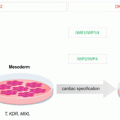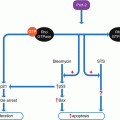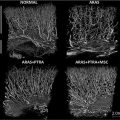M.A. Hayat (ed.)Stem Cells and Cancer Stem CellsStem Cells and Cancer Stem Cells, Volume 122014Therapeutic Applications in Disease and Injury10.1007/978-94-017-8032-2_10
© Springer Science+Business Media Dordrecht 2014
10. Decellularized Stem Cell Matrix: A Novel Approach for Autologous Chondrocyte Implantation-Based Cartilage Repair
(1)
Stem Cell and Tissue Engineering Laboratory, Department of Orthopaedics, West Virginia University, 3941 Robert C. Byrd Health Sciences Center South, 9196, Morgantown, WV 26506-9196, USA
(2)
Stem Cell and Tissue Engineering Laboratory, Department of Orthopaedics, West Virginia University, 3943 Robert C. Byrd Health Sciences Center South, 9196, Morgantown, WV 26506-9196, USA
Abstract
Cartilage defects due to injuries of the knee result in more than 200,000 surgical procedures annually. Current conservative and operative treatments prove inadequate at fully repairing/resurfacing the defects. The most promising cell-based therapy, autologous chondrocyte implantation (ACI), has evolved for generations and is successful in young patients though long-term clinical outcomes are not yet known. The major limitations for current ACI are autologous chondrocyte shortage and dedifferentiation during monolayer expansion. Stem cells, especially tissue-specific stem cells, may be able to overcome autologous chondrocyte shortage in future ACI treatment due to their self-renewal, multi-lineage differentiation potentials, and lack of ethical issues. Synovium-derived stem cells have been suggested to be a tissue-specific stem cell for cartilage regeneration due to their excellent chondrogenic capacities both in vivo and in vitro. For the concern about cell dedifferentiation during expansion, decellularized stem cell matrix could provide an ex vivo expansion system to rejuvenate and/or reprogram expanded cells in proliferation and chondrogenic potential. The combination of a tissue-specific stem cell and decellularized stem cell matrix would help provide large-quantity and high-quality cells to improve cartilage regeneration and benefit cartilage repair, which will greatly advance the development of next generation ACI in the near future.
Introduction
Cartilage functions as a pivotal part of the joint environment. Its unique mechanical properties allow consistent frictionless movement over a lifetime. However, cartilage is a poorly vascularized tissue with limited self-healing ability. Other than trauma and aging, degenerative osteoarthritis is the leading cause of cartilage defects. Cartilage injuries of the knee affect approximately 900,000 Americans annually, resulting in more than 200,000 surgical procedures (Cole et al. 1999). Chondral defects are seen in 34–62% of knee arthroscopies in young patients with a median age of 35 years old (Widuchowski et al. 2007).
Drug therapy and physiotherapeutic interventions at present can improve symptoms of joint dysfunction and relieve pain. Unfortunately, no clinical research studies to date have proven that any drugs have the ability to inhibit cartilage degradation or reverse the degenerative process. Operative treatments repair cartilage defects completely by fixing the detached cartilage fragment or by chondrocyte transplantation and tissue regeneration. Current surgical procedures include debridement/chondroplasty, bone marrow stimulation techniques (i.e., microfracture, drilling), osteochondral autografting/allografting, and cell based therapies using autologous chondrocyte implantation (ACI). Despite substantial differences in the complexity and technical application of each method, the ultimate goals of successful cartilage repair are reducing pain; improving symptoms and long-term function; preventing early osteoarthritis and subsequent total knee replacements; rebuilding hyaline cartilage instead of fibrous tissue; and preventing degeneration. Clinical studies have reported outcomes for each technique according to different lesion sizes and the age of the patients. Though short-term success and a low failure rate have been achieved by generations of ACI, the long-term effect of the procedure and the results of full-thickness defect repair are not clear (Harris et al. 2011).
Fortunately, emerging technologies and the next generation of cartilage tissue engineering provide hope. The major areas that investigators are studying include a tissue-specific cell source, a biocompatible scaffold, and an optimal in vitro culture environment with bioactive molecules to promote and control proliferation, cellular differentiation, and maturation. First of all, stem cells, especially adult stem cells with self-renewal and multi-lineage differentiation potentials, are a more accessible cell source with no ethical issues compared to embryonic stem cells. Among the adult stem cells, bone marrow derived stem cells (BMSCs) are the first and most widely investigated and adipose derived stem cells (ASCs) have gained more popularity recently due to ease of collection from liposuction (Hildner et al. 2011). Unfortunately, chondrogenically differentiated BMSCs become hypertrophic and eventually result in endochondral bone formation; ASCs have a limited ability toward chondrogenic differentiation. Recently, synovium-derived stem cells (SDSCs) have been suggested as a tissue-specific stem cell; they possess superior chondrogenic potential both in vitro and in certain in vivo states (Pei et al. 2008; Jones and Pei 2012). Secondly, extracellular matrix (ECM) is known as a key component of the stem cell niche in vivo. It functions as a reservoir for growth factors and provides natural and intrinsic cues to direct the remodeling process during cell differentiation. Decellularized ECM (DECM) has been successfully used as a scaffold in tissues such as adipose and organ regeneration, such as lung, heart, brain, liver, and bladder (Hoshiba et al. 2010). Most recently, decellularized stem cell matrix (DSCM) from SDSCs has been demonstrated to provide a three-dimensional substrate to enhance cell proliferation and chondrogenic potential, possibly by immobilized biomolecular signals. This chapter will focus on causes of cartilage defects, the current status of ACI based cartilage repair, matrix based next generation cartilage repair, and future prospects.
Causes of Cartilage Defects
Osteoarthritis, trauma, and metabolic disorders of the subchondral bone, such as osteonecrosis or osteochondritis dissecans are the primary causes of cartilage defects (Madry et al. 2011). In 1,000 knee arthroscopies, 61% of the knee joints had cartilage defects; 44% of them were due to osteoarthritis, 28% were due to focal cartilage defects, and 2% were due to osteochondritis dissecans (Hjelle et al. 2002). Osteoarthritis is the most common articular disorder and a highly prevalent disease. It affects more than 20% of American adults and 10% of men older than 60 develop osteoarthritis. The current understanding about osteoarthritis is that it is a disease of the entire joint and not only a pathological degradation of articular cartilage. Inflammation of synovial membrane causes release of chondrotoxic proteins leading to cartilage destruction. Typically, osteoarthritis is characterized by areas of poorly delineated defects. Untreated cartilage defects resulting from trauma or osteochondritis dissecans tend to predispose patients to the development of osteoarthritis.
Aging is the accumulation of changes in a person over time. It affects every organ to a different degree. Aged chondrocytes are less responsive to mechanical and inflammatory stimuli. Their protein secretion has been altered, as evidenced by decreased anabolic activity and increased production of proinflammatory cytokines and matrix-degrading enzymes. The above changes make cartilage more susceptible to damage and can lead to the early onset of osteoarthritis. Age has an influence on cell properties when using ACI (Pestka et al. 2011). Cartilage is vulnerable to traumatic injury; due to its avascular nature, inability to access MSCs, and the irreversible aging process, the ability of cartilage to self-heal is disappointing. Patients with symptomatic cartilage defects often report pain, swelling, joint locking, stiffness, and clicking. Symptoms may cause significant functional impairment, often limiting one’s ability to work, play sports, and perform activities of daily living.
Autologous Chondrocyte Implantation Based Cartilage Repair
The first generation of ACI was introduced in 1987 and published in 1994 (Brittberg et al. 1994). The procedure involves harvesting autologous chondrocytes from non-weight bearing aspects of the knee. Chondrocytes are then isolated by collagenase digestion and expanded in vitro. During a second surgery, the cartilage defect is debrided up to the healthy edges and covered with an autologous periosteal patch, taken from the medial tibia. Finally, the suspension of healthy autologous cultured chondrocytes is directly injected into the chondral defect under the periosteal patch. Despite significant improvements and positive clinical reports, the adoption of periosteal based ACI (ACI-P) has been limited partly owing to post-operative complications such as cell leaking and periosteal-related hypertrophy.
The second generation of ACI is known as collagen-covered ACI (ACI-C) and is characterized by the application of a bioabsorbable collagen membrane in place of the periosteal flap. The chondrocytes are cultured with collagen membrane for several weeks; the membrane is then cut to the correct size and shape of the cartilage defect. Despite ACI-C showing similar clinical improvements and fewer complications, cutting and repeated manipulation of the seeded membrane may result in the loss of critical chondrocytes. A modified ACI-C technique has been developed in which expanded chondrocytes are applied to the collagen membrane after it has been cut to size, reducing the risk of viable cell loss while retaining the ease and speed of the technique. However, ACI-C still suffers from technical problems such as insufficient mechanical stability, uncertain cell distribution within the defect, and the necessity of an intact cartilage shoulder surrounding the defect.
The third generation of ACI is tissue-engineered matrices seeded with autologous chondrocytes; it is called matrix associated/induced ACI (MACI). Cultured autologous chondrocytes are directly seeded onto biodegradable collagen type I/III membrane or allowed to penetrate into a three-dimensional (3D) scaffold or fleece prior to intra-articular implantation. The cell carrier based MACI technique procedure was recently reviewed by Brittberg (Brittberg 2010). Several commercially available products have been developed and marketed in Europe, such as MACI®, Hyalograft® C, Novocart® 3D, and BioSeed®-C etc. (Harris et al. 2011). The widely adopted MACI® used in routine orthopaedic practice is the only third-generation cell carrier that is currently being evaluated in a randomized, controlled trial to meet European regulations for marketing approval and potentially those of other countries. MACI minimizes donor site morbidity by avoiding the harvest and implantation of a periosteal flap. The 3D cultures that MACI can provide also solve the problem of chondrocyte dedifferentiation during expansion and serve as a barrier to fibroblast invasion.
Scaffolds made of natural biomaterials, such as collagen and hyaluronic acid, can maintain the expression of aggrecan and collagen type II in chondrocytes. For instance, collagen has been intensively studied as a natural polymer with respect to cartilage tissue engineering. Chondrocytes cultured within collagen gels preserve their phenotype and glycosaminoglycan (GAG) production for as long as 6 weeks in culture (Kimura et al. 1984). Matrices and membranes derived from collagen also stimulate chondrocytes to produce new collagen (Zheng et al. 2007). Hyaluronan, a highly concentrated component in the ECM of articular cartilage, is also a good candidate for biodegradable and biocompatible scaffold material. Chondrocytes cultured with chemical cross-linking hyaluronan scaffold express more chondrogenic markers, collagen type II, aggrecan, and less collagen type I (Grigolo et al. 2002). Other natural polymers derived from ECM used in cartilage engineering as 3D culture systems include fibrin glue, alginate, agarose, chitosan, chondroitin sulfate, gelatin, and silk fibroin (Danisovic et al. 2012).
Stay updated, free articles. Join our Telegram channel

Full access? Get Clinical Tree







